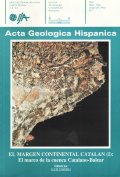Tesis doctoral: Análisis del contenido en agua en formaciones salinas. Su aplicación al almacenamiento de residuos radioactivos
Abstract
Rock salt formations are one of the suitable host rocks for high radioactive waste disposal. Among the site selection criteria, one of great importance is the presence of water in the host rock. Due to their genesis and to their mineralogical composition salt formations always contain small amounts of water. This water can be present as interstitial brine, in hydrated minerals and as intragranular fluid inclusions. In order to define the range of water content present in rock salt, as well as its relation between mineralogy and stratigraphical position, five rock salt types have been studied. For each sample water content and also mineralogical analysis has been performed. In most of the studied samples water is present as interstitial bnne and fluid inclusions. In some cases water can also be present in form of hydrated minerals. The distribution of the water content is usually of lognormal type. In some rock salt formations, severa1 subpopulations could be found. Total water content ranges from 0.01 to 3.50%.
Mathematical treatment on the aforementioned data consisted of the estimation of the error related to the sampling procedure, statistical tests (univariant, ANOVA, correlation, PCA and trend analysis) and Geostatistics. These treatments have allowed to discern between waternch and water-poor rock salt and also to confirm that there are three factors controlling the amount of water content: mineralogical composition, halitic lithofacies and degree of tectonic stresses. Geostatistical analysis has shown that for detailed characterization purposes a sarnpling interval of 1 m is convenient, whereas for a first characterization of a salt formation a sampling interval of 5 m seems reasonable.
Finally, trend analysis has confirmed that along a rock salt formation, alternancy of water-rich and water-poor zones may exist. The methodology described in this study can be very useful for site characterization purposes. Data arising from laboratory research on the aforementioned parameters combined with safety assessment methods can provide the technical basis to decide whether the proposed disposal site offers a satisfactory leve1 of safety.


